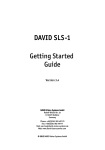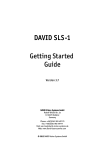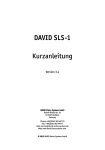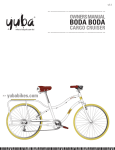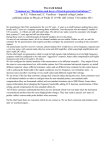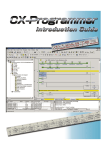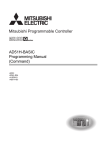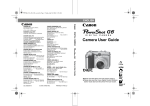Download DAVID SLS-2 Specifications
Transcript
QUICK GUIDE Contents 1. Introduction 1.1. Intended Purpose 1.2. Safety Instructions 1.3. Scope of Delivery 1.4. System Requirements 27 27 27 28 28 2. Initial Setup 2.1. Position of the Camera 2.2. Rotation of the Camera 2.3. Connection 2.4. Installing the Camera Driver 2.5. Setting up the Projector 2.6. Setting up the Projector as Extended Desktop in Windows 29 29 29 30 30 31 31 3. The Scan Software DAVID 3.1. Software Updates 32 32 4. Setup and Calibration of the Scanner 4.1. Menu ”Hardware Configuration“ 4.2. Menu ”Calibration“ 33 33 35 5. 3D Scanning 5.1. Menu ”Structured Light“ 5.2. Menu ”Texturing“ 37 37 39 6. Alignment and Fusion of Multiple Scans 6.1. Menu ”Shape Fusion“ 6.2. Alignment of Multiple Scans 6.3. Fusion of Multiple Scans 40 40 40 42 7. Disposal / Recycling 43 8. Troubleshooting 8.1. Problems with the Scan Quality 8.2. Problems with Alignment / Fusion 8.3. Other Problems and Solutions 44 44 46 47 9. Terms of warranty 10. Copyright 11. CE Declaration of Conformity 48 48 49 26 1. Introduction Thank you for choosing a DAVID product! In order to setup and run your 3D scanner safely, please read the following safety instructions. This manual is part of this product. In case of passing this product, please enclose this guide. 1.1. Intended Purpose With your DAVID SLS-2 Structured-Light Scanner, you can quickly and accurately capture object surfaces three-dimensionally. 1.2. Safety Instructions Place the appliance on a stable surface. Dropping the unit may severely damage it, and the glass calibration panels may break. Caution: Risk of cuts! Do not place the device on a vibrating surface to prevent damage of internal components and battery leakage. Operate the device only in a dry environment. Do not operate the device in potentially explosive atmospheres. Never look directly into the projector lens when the lamp is turned on. The bright light may cause serious damage to eyes. Do not face the projector lens to the sun. It can result in fire. Do not attempt to disassemble this projector. There are dangerous high voltages inside the unit. Do not use the device if it is broken or has been dropped. In this case, contact your dealer for inspection. Stop using the device when there is smoke, unusual noise or smell. That could result in fire or electric shock. In this case immediately disconnect the power plug, and contact your dealer. Do not insert any objects into the openings of the projector chassis. That way you might come into contact with dangerous voltage points or create a short circuit between the parts. That could result in fire or electric shock. Do not spill liquid of any kind onto or into the device. 27 The projector‘s power adapter is equipped with a three-wire grounded plug. The plug only fits in a grounded power outlet. Make sure that the power outlet is properly grounded before inserting the AC adapter plug. Do not insert the plug into a non-grounded socket. Please contact your electrician for details. Warnings! The grounding pin is a safety feature. Using a not properly grounded socket may result in electric shock and/or injury. Do not make any changes to any components. Repairs to the device must be performed only by an authorized dealer or qualified service personnel of DAVID Vision Systems GmbH. Observe the safety instructions of the projector manufacturer. These can be found separately on the accompanying ACER projector CD. 1.3. Scope of Delivery • Structured-Light Scanner pre-assembled, consisting of: – LED video projector – Camera with lens – Base rail with camera slide • Tripod with protective bag • Glass calibration panels + 2 fixing brackets 90° • USB flash drive with DAVID-Laserscanner Pro Edition and camera drivers • Projector Accessories – External power supply and power cable – Remote control – Adapter VGA to Universal I/O – VGA cable – HDMI cable – Protective bag Technical changes are subject – User Instructions to change without prior notice. • Adapter kit for power supply worldwide • USB cable for camera • Cable strap 1.4. System Requirements • Windows XP, Vista, 7 or 8 (32-bit or 64-bit) • Microsoft. NET Framework 4.0 (32-bit) or 4.5 (64-bit) • 3D-capable graphics card • Free VGA or HDMI port • Two free USB ports • Recommended: Dual-core processor, 2 GHz, Windows 7/8 64-bit, 8 GB RAM, NVIDIA or AMD graphics card 28 2. Initial Setup 2.1. Position of the Camera The camera can be mounted on the right or left side of the projector: Size of the scan object / scan area Position of the Camera (seen from rear) up to 110 mm to the left of the projector 110 to 350 mm optional, better to the left from 350 mm to the right of the projector If necessary, mount the camera slide to the corresponding side. The exact position of the slide (distance from the projector) is set later in operation. The distance between the camera and projector optics will be similar to the size of the object/region to be scanned. Figure 2.1: Left: Small object Z short distances; Right: Large object Z greater distances 2.2. Rotation of the Camera Rotate the camera by about 22° such that it aims at the projection area. (Fig. 2.2) To do this, loosen the thumbscrew under the camera. Set the rotation angle by means of the degree scale on the camera slide, then fix the thumbscrew. Figure 2.2: Setting the camera angle 29 TIP: For very large objects, or objects with deep cavities, a smaller camera angle may be necessary. Angles less than 20° result in reduced scan quality (noise, inaccuracies). A very large camera angle (> 30°), may improve the scan quality a little, but is only suitable for very flat objects. Large camera angles are usually impractical and reduce the depth of the measurement range. 2.3. Connection Connect the camera, the projector and the DAVID USB flash drive according to the wiring diagram to your computer (Fig. 2.3). To connect the projector to your computer, you can use HDMI (recommended) or VGA. Figure 2.3: Connection diagram 2.4. Installing the Camera Driver Even if Windows installs drivers automatically, please install the supplied drivers: 1 Connect the USB flash drive to your PC, then select ”Browse“ or Explorer / My Computer. 2 Start ”Install_DAVID-CAM-3 M_Driver“ (administrator rights required). 3 Follow the instructions on the screen. 30 2.5. Setting up the Projector The projector is already delivered with optimal settings, we recommend not to change anything in the menu. Note: You can restore the recommended settings in the projector‘s menu at any time as follows (See Figure 2.4.) 1 Select ”Reset“ 2 Turn the ”Auto Keystone ” off, and set the manual value ”Manual Keystone“ to 0 3 As ”Projection Location“, select the icon for desktop use, not ”AUTO“ Figure 2.4: Projector settings Note: You can activate the ”Eco-Mode“ if you do not need the maximum intensity of light. For details, please read the manual of the projector. 2.6. Setting up the Projector as Extended Desktop in Windows Click the right mouse button on a blank area of your Windows desktop, select “Screen resolution“ or ”Properties“ (depending on your Windows version). Figure 2.5: In this window you can separately configure your two ”Displays“, the monitor and the projector. (Image may vary) 31 Your screen should be set as ”primary monitor“. Make sure the projector (usually ”Acer K132“) is set as extended desktop (”Extend these displays“). This is necessary so that DAVID can project the stripe patterns, while the user interface is displayed on your screen. The resolution of the projector must be set to its native value (usually 1280 * 800 pixels) Furthermore, you should make sure the projector is set to 60 Hz. Choose the Projector and click ”Advanced“, here you should set the refresh rate to 60 Hz in the ”Monitor“ tab. A more detailed description can be found in our online manual in the section ”Structured Light 3D Scanning“ on http://www.david-3d.com/manual When these settings are correct, your monitor and projector will show the same desktop wallpaper, but otherwise different contents. You can move your mouse pointer sideways between the monitor and the projector image. The Windows Start menu and most of the desktop icons are only displayed on the monitor. Any window can be moved between monitor and projector back and forth. So in case the main DAVID window is displayed on the projector, please grab its title bar with the mouse and drag it sideways onto the monitor. 3. The Scan Software DAVID Start DAVID by running ”Start_DAVID3_x64“ from the USB flash drive. If you use a 32-bit system (not recommended), run ”Start_DAVID3“. On the left side, the main menus are stacked, and can be individually opened and collapsed. Each menu is responsible for one work step, which you will usually go through from top to bottom. This printed manual refers to version 3.10 of the software and may already be out of date. Please follow the detailed and always up-dated on-line instructions at http://www.david-3d.com 3.1. Software Updates Our software is constantly being developed and improved. All updates within version 3.x are free. Therefore use the automatic update feature, or download updates manually from our website: http://www.david-3d.com 32 4. Setup and Calibration of the Scanner An advantage of the modular design of the SLS-2 is that it can be adjusted to scan a wide range of objects sizes. Therefore, a calibration (measurement of the scanner hardware in the software) is necessary so that the software can then obtain precise and undistorted 3D data at the correct scale. For this purpose, a 90° pair of glass calibration panels is used as a reference object, whose dimensions are precisely known. 4.1. Menu ”Hardware Configuration“: Alignment and Setup of the Projector and Camera 1 Main setting: Select ”DAVID SLS-2“ as ”Setup Type“. 2 Screen ID: Here you can select on which display device the stripe pattern is shown. Set the ”Screen ID“ so that the pattern is projected from the projector. 3 Working distance: Place the scanner in front of the object to be scanned and aim the projector so that it illuminates the surface to be scanned - not less, but also not much more. (See Figure 4.3) 4 Projector focus: Adjust the focus of the projector with the focus lever, so that the stripes are perfectly focused on the object surface. 5 Selection of camera: Under ”camera“, select your camera (DAVID-CAM-3.1-M). The live image from the camera is displayed. If necessary, set the mechanical aperture and focus so that you get a picture. 6 Position of the camera: Move the camera slide by Figure 4.1: ”Hardware Setup“ menu loosening the thumbscrew so that the camera is aimed on projected pattern on the object. Then fix the camera slide. If the viewing range of the projector and/or camera contains much more than the surface to be scanned, you should reduce the working distance of the scanner (step 3). 7 Exposure time: The Exposure should be set to the same value as the frame rate of the projector (usually 1/60s), otherwise the camera image will flicker/pulsate when looking at the projection. In this case adjust the exposure time. 8 Camera focus (See Figure 4.2): Adjust the aperture of the camera (dial A) so that you will get a rather bright picture. Look at the camera image and watch the sharpness of the object and the sharpness of the projected black and white stripes (cross). Adjust the focus of the camera (dial B) so that the object is depicted as sharp as possible. 33 C B A Figure 4.2: Adjusting rings (A) aperture and (B) focus, (C) fixing screws 9 Camera brightness/aperture: The ”Projector Brightness“ slider in the software should be set to maximum. You should only reduce it if a clean modulation is not possible in the following. Adjust the mechanical aperture (dial A). Consider only those areas in the camera image which show the regular waves! The displayed intensity curves (red) must be sinusoidal and may neither be undersaturated nor oversaturated, i.e. the red sine curve (see Figure 4.4 and 4.5) should not be cropped at the blue lines. Figure 4.3: Setup of the object and arrangement of the projector and camera Figure 4.4: Typical live image with good setup and settings Figure 4.5: Left: Too dark Z open aperture further; Middle: Well-controlled sine wave almost reaching the blue borders; Right: Too bright, sine is cut-off (overdriven) Zclose the aperture somewhat If the curves are strongly flattened in the dark area (bottom or left) without being close to the lower blue lines, the ambient light may be too strong. In this case please darken the room. Note: The aperture dial (A) on the camera has a scale (f-stop from 16 to 1.4), see Figure 4.2. Even for very bright conditions (small objects), please avoid setting f-stop higher than 16, otherwise you will lose sharpness. If necessary, better reduce the value ”Projector Brightness“ in the software. 34 10 Fasten all screws (projector, camera and camera slide), so that nothing can be displaced from now on. The camera lens dials can be fixed with their locking screws (C). The scanner is now optimized for your object (size of the scanning area, working distance, brightness of the object) and must be calibrated like this. 4.2. Menu ”Calibration“: Calibration of Camera and Projector 1. Now set up the calibration corner. You will need both 90° fixing brackets and the glass calibration panels. Put one fixing bracket flat on the used surface (e.g. a table). Insert the glass calibration panels in the fixing bracket. Finally, attach the second fixing bracket on the glass calibration panels (Fig. 4.6). Attention: Please take note of our safety advices in Chapter 1.2. 2. Choose the calibration pattern whose size fits to the scanned object. The pattern should be slightly larger than the object/region to be scanned (Fig 4.8). For object sizes above ca. 200 mm, use the large 240-mm pattern on the back. Figure 4.6: Setting up the glass calibration panels For starters, the pattern should be folded inwards (Fig. 4.8). Advanced users can avoid undesired reflections with an outwardly folded pattern if necessary. Fix the glass calibration panels using the two fixing brackets to exactly 90°. Figure 4.7: ”Calibration“ menu Figure 4.8: Calibration pattern too small Suitable calibration pattern Calibration pattern too large 3. Remove the object and set up the glass calibration panels and the scanner in front of each other, about the same distance as the object previously, so that the projection and camera image are sharp. Camera and projector should not look at a too flat angle at the calibration panels. The camera image should show the projected pattern as large as possible. In addition, the 6-rings and several other points of the calibration pattern must be visible. The entire camera image should be filled with about 15 to 70 calibration markers, the camera should not be able to look aside the glass calibration panels. You can achieve this by moving the scanner and tilting or adjusting the tripod, but you should not change anything above the red base rail. 35 4. Enter the correct scale length in the ”scale [mm]“ field. You can find it on the edge of the selected calibration pattern. (30, 60, 120, or 240 - see Figure 4.10) 5, Check the camera image: In the areas where the waves are visible, the red intensity curves must not reach the blue lines. If the object to be scanned is considerably darker than the white glass calibration panels, the sine waves will now be overdriven. Correct this by temporarily reducing the ”Projector Brightness“ slider in the software. The camera image for calibration should look similar like shown in Figure 4.11. 6, Click ”Calibrate“ to calibrate the entire scanner. In this step, the software first measures the position, orientation, focal length and distortion characteristics of the camera. Then, a pattern sequence is projected in order to measure the same optical characteristics of the projector. If texturing is not turned off, finally a white balance is performed. After successful calibration, a checkerboard pattern is projected, the corners of which should fall exactly into the calibration points. Figure 4.9: Typical setup for calibration Figure 4.10: Entering the size of the calibration pattern The scanner is now calibrated. This refers to the position and rotation of camera and projector according to each other, as well as focusing and brightness settings. You can move, tilt and rotate Figure 4.11: Ideal live camera image for calibration the scanner as a whole, and you can close the DAVID software and restart it without losing the calibration. You can also change the value of ”Projector Brightness“ to adjust the brightness (red sine curves) to the respective object to be scanned. However, if you rotate or move camera and projector separately or adjust the focus (for example for scanning significantly larger or smaller objects), the entire calibration process must be repeated. 36 5. 3D Scanning 5.1. Menu ”Structured Light“: Z Place the scanner and the object in front of each other, at the same distance as during setup and calibration. With a wrong working distance, the camera image and projected stripes would be blurred. If necessary, correct the distance between object and scanner, but by no means change the focus of camera or projector. Important: Before each scan please check that the red sine curves are not cropped / overdriven (relevant only in the areas where the wave pattern is visible). If adjustment is necessary, adjust the ”Projector Brightness“ in the software. Z Select the pattern parameter ”Quality“, ”Default“ (recommended) or ”Speed“. This setting affects scan quality and scan time. Z With each click on ”Start“ a new scan is generated. A sequence of patterns is successively projected and recorded. This can take between settings 2-4 seconds or longer. Figure 5.1: Menu ”Structured Light“ Figure 5.2: Typical camera image immediately before the scan 37 Figure 5.3: Display of the scan result in 3D Z If you activate ”Auto. Grab Texture“, a color texture will be recorded with each scan. If the texture is too bright or too dark, you can adjust its settings in the ”Texturing“ menu (see next sub-chapter). You can toggle the visibility of the texture in the 3D view using the appropriate button under ”Visibility“. Z Using the mouse, you can rotate the 3D view (right mouse button), move (left mouse button) and zoom (mouse wheel). Z With the ”Live“ button under ”View“ you can return to live video feed. Z To assure that multiple scans of the same object can be well combined later, they must overlap sufficiently. You usually will need about 6-8 scans all around the object, maybe plus some angular views of top and bottom. Textures can help later when aligning multiple scans. Z With the smoothing filters under ”Result Filtering“ you can smooth the 3D scan result manually. However, we recommend not to do this (set filters to 0). If your scans are noisy or wavy, you should rather optimize the scanning conditions (brightness settings, room conditions). More smoothing options are available in the Shape Fusion menu later on. Z The filter ”Quality check“ removes scan data that are likely to be inaccurate. This is possibly on the edge of the scan or at transitions between light and dark areas. You can change the filter value and see the effect immediately on the scan. The recommended value is 0.5. Z Save each successful scan as an OBJ file (”Save As...“) and/or add it to the scan list (button ”Add to List“)). After each click on ”Add to List“, you can align the new scan immediately to the previous scans (Shape Fusion menu, see next chapter). Alternatively, you can first create further scans in the ”Structured Light“ menu, collect them in the list, and align them all later. Z If the settings are optimized, and you do a lot of scans in a row, you can accelerate the workflow with the ”Auto. Add to List“ and/or ”Align to Previous Scan“ options. This is recommended only for experienced users. 38 5.2. Menu ”Texturing“: You can grab a color texture with each scan. Because of the monochrome camera of the SLS-2, the color texture of the object will be determined by measuring the reflective properties. Therefor the projector pictures different colors on the object surface. DAVID is able to interpret the reflections and converts them into a real color texture. For the texture grabbing, different lighting conditions may be ideal. When the ”Texturing“ menu is open, you can make optimizations (projector brightness, exposure time, camera properties) without influencing the scan settings. A good texture is like a clear photo: evenly lit, not too bright, not too dark. The projected color stripes should be visible in the camera image as light gray stripes (not too dark, but not white). Figure 5.4: Menu ”Texturing“ If necessary, it is advisable not to use the projector as a light source (”Projector Brightness“ to 0) but to provide diffuse ambient light in the room. In that case, of course, the monochrome camera can only grab a gray-scale texture. White Balancing: Whenever you change the texture settings, you should re-perform the white balancing. That means DAVID calibrates color transmission characteristics of the entire system (projector, camera), in order to be able to measure the colors of the object correctly. For white balancing, the camera image must show exclusively a large white object (such as the glass calibration panels or a white wall). Then click ”Adjust White Bal.“ Z With the ”Grab texture“ button, the current scan is provided with a new texture. Z Settings here are stored separately. For the following scans, you will not have to go to the menu ”Texturing“ each time, instead you can activate the ”Auto. Grab Texture“ option in the ”Structured Light“ menu (See Figur 5.1). 39 6. Alignment and Fusion of Multiple Scans 6.1. Menu ”Shape Fusion“ This menu provides functions to 1. align and 2. fuse/merge several scans into a single 360° model. The fused object subsequently can be exported to various formats, to be used e.g. for 3D printing. In the following, we will describe the general case how to fuse variously positioned scans. Notes on special cases and more detailed information can be found on http://www.david-3d.com/manual 6.2. Alignment of Multiple Scans Figure 6.1: Menu ”Shape Fusion“ Z In general, the individual scans are collected via the ”Add to List“ button during scanning. You can import more scans (OBJ) into the List of Scans - either by drag and drop from the Explorer, or using the ”+“ icon below the list. Z In the list individual scans can be made visible/invisible by click on . Z If you want, you can clean up your scans with the ”cleaning“ tool. At this point, you should delete only surface segments that are not helpful for the alignment, e.g. do not delete surfaces that multiple scans have in common. Z Using the buttons you can arrange all scans side by side, to get a good overview. Figure 6.2: Single scans prior to alignment, arbitrarily arranged 40 Z DAVID offers several alignment modes. First, start with the alignment mode ”Free“, which allows you to align arbitrarily positioned scans one-on-one. In order for the automatic mode to align two scans successfully, the two scans must have a unique region of overlap in common, which must not be too small. With start the alignment. In the 3D view, first click on the object A to be aligned. Then click on the object B, to which A should be aligned. In Figure 6.3, the blue scan will be aligned to the green one: Figure 6.3: Automatic alignment with two mouse clicks Successively align more scans to the already aligned scans. Always choose pairs that have as much overlap (common areas) as possible. In the above example, the next step would be to align the yellow to the blue scan: click on the yellow, then the blue scan, etc. Z When all scans are aligned, a run of ”Global fine registration“ is recommended. Choose that mode instead of ”Free“, then click ”Align scans“. Figure 6.4: Scans after alignment Figure 6.5: Fusion result (with ”close holes“ option) Z All movements can be individually made undone by the ”undo“ button. Z You can save your single scans at any time. They will be stored in their current position and rotation in 3D space, so you would not need to align them again. For this, use the Save buttons below the ”List of Scans“. 41 Z If the automatic alignment finds false solutions, you should activate ”Contact Pair Selection“ . Then you can help DAVID by clicking on distinctive points that are to be aligned with each other (e.g., tip of the nose). Relevant here is the area within the red circle at the mouse pointer. If you would like to define the contact pair points very precisely, zoom up close with the mouse wheel before you click. If you want to mark the contact area only roughly, zoom out before you click. Z After a few registration steps, it may be helpful to group two or more aligned scans temporarily. Simply select two or more scans in the ”List of Scans“ (check the checkboxes of the respective scans), click with the right mouse button and select ”Combine selected scans”. This allows you to group scans (temporarily) and use them as if they were a single scan. In our example (Büssing bust, Figure 6.2) we could combine scans 1 and 4 just before the alignment of the 5th. In this way, the 5th scan will be aligned simultaneously to both, which can lead to more overlap and thus better results. To un-group, click with the right mouse button on the entry in the list and select ”Uncombine scans”. 6.3. Fusion of Multiple Scans Z Make all scans visible , which you want to fuse. Invisible scans will not be included in the fusion. Z First, try a small ”resolution“ value. High values cause to very long computing time and higher memory usage. Z The ”refinement“ option in some cases can improve the accuracy and sharpness, but it often causes distortions. Feel free to try it, depending on the object. Z Click on ”Fuse“ to start the fusion process. This is a computationally intensive process and will take a few seconds to several minutes. The visible scans are merged to form a closed triangle mesh, holes are (optionally) closed, smaller artifacts are removed, and if the scans have textures, a common texture is generated. For example see Figure 6.5. Z Finally, you can export your fused 3D object into an OBJ, STL or PLY file by using the ”Save“ button. 42 7. Disposal / Recycling The electronic components of the DAVID 3D scanner, including disused batteries or accumulators, may not be disposed of as household waste. Every consumer has a statutory obligation to properly dispose of these items at officially designated points of disposal. In accordance with the EU Directive 2002/96/ EC on waste electrical and electronic equipment this must be disposed of in accordance with local regulations. You can dispose of the product at your local public point for collection of electronic waste. You can also return the product to us for disposal. In that case, please use the following address: DAVID Vision Systems GmbH c/o RECYCLING Rudolf-Diesel-Str. 2a 56070 Koblenz Germany Batteries containing hazardous substances are marked with the symbol of a crossed out wheelie bin. Below that symbol the appropriate chemical name of the pollutant is given. The terms have the following meanings: Cd = battery contains cadmium Pb = battery contains lead Hg = battery contains mercury 43 8. Troubleshooting 8.1. Problems with the Scan Quality Problem Cause / Solutions The scans are noisy (rough surfaces) Adjust the camera aperture (f-stop) so that the red intensity curves are welladjusted and not being cropped. (*) Set the projector‘s brightness to maximum. Increase the camera angle (at least 20°) and the distance between the camera and projector. (*) Set the value ”Gain“ in the camera properties to minimum (*) Select pattern parameter ”Default“ or better ”Quality“. Reduce the ambient light. The scans show a regular wave pattern Make sure that the red intensity curves are neither overdriven nor too weak. Flattened sine waves cause waves in the scan. (*) Reduce the ambient light. Avoid fluorescent lights and all flickering light sources. Make sure that in the projector‘s menu, all filters are adjusted to neutral (default values) and no artificial contrast enhancement, etc. is active. (*) On shiny objects, direct reflections of the light projector in the camera should be avoided. The object must be matted with spray if necessary. We recommend our Coating Spray, order number: COATING-SPRAY-500 Make sure that the camera image does not flicker, meaning that the exposure time of the camera fits to the frame rate of the projector (usually 60 Hz and 1/60s). During the scan, nothing is allowed to move (scanner, object). A scanned person should lean against sth. as comfortably as possible, and hold their breath. The scans show strip-shaped distortions Make sure that the resolution of the projector is set correct. It should be set to the native resolution, usually 1280 * 800 pixels. (*) Make sure in the projector‘s menu that the keystone correction is off: Set the manual value to zero and deactivate the automatic. (*) (*) Requires recalibration Other possible problems and their solutions can be found on our website in the FAQ: 44 http://www.david-3d.com 8.1. Problems with the Scan Quality Problem Cause / Solutions The scans are smooth / fine details are missing The shorter the distance between the scanner and the object, the more detailed are the scans. Set up the scanner at the smallest possible working distance, so that the scan size is just sufficient. Make sure that the distance between scanner and object is the same as during the calibration. Make sure that both, projector and camera, are well focused on the scanned object. The scanner can capture only details that are not finer than 0.1% of the scanned surface (min. 0.06 mm). The scans contain irregular distortions / outliers Make sure that the ambient light is constant. Make sure that nothing moves in view of the camera, not far behind the object as well. Make sure that the object and scanner do not move. On shiny objects reflections should be avoided. The object must be matted with spray if necessary. We recommend our Coating Spray, order number: COATING-SPRAY-500 Use a dark background / table cover, which reflects almost no light (e.g. black fabric). If outliers can not be avoided, you can remove them later in the Shape Fusion menu (”Cleaning tool”). Often, the most comfortable way is to clean up all scans at the same time before aligning them. Small outliers will be automatically removed in the final processing step, Fusion. The color textures do not look good Open the ”Texturing“ menu and perform a new white balance. Other possible problems and their solutions can be found on our website in the FAQ: http://www.david-3d.com 45 8.2. Problems with Alignment / Fusion Problem Cause / Solutions Shape Fusion: The scans are aligned completely wrong DAVID aligns the scans such that the overlapping areas are maximized. That maybe causes wrong solutions if there are more than one matching overlapping areas. Start the alignment again. The algorithm is in part randomized and therefore it can find another solution next time. Use the ”Contact Pair Selection“ to define by mouse a pair of regions which are supposed to overlap. The scans should overlap at least about 30%. The more overlap there is, the more likely the correct alignment is found. If you have rotated the object only about the vertical axis (parallel to the axis of the calibration corner) and if you have not tilted the scanner after calibration, you can choose the ”Around Y-Axis“ alignment mode. If you know the approximate angle of rotation between scans, enter it in the ”Rotation Angle“ field. Depending on the direction of rotation you may have to enter a negative value. If the object has color transitions or markings, take a texture with each scan, and activate “Use Texture” when aligning. In difficult cases, you can manually align the scans: Click on the scan to be moved, then hold down the Ctrl key and move/rotate the scan with the mouse (left/right mouse button). Release the Ctrl button temporarily to change your viewing direction. With practice, this can be achieved quite quickly. When you have reached an approximate alignment with some overlap, use the mode ”Pairwise fine registration“ in order to perfect your solution. Shape Fusion: The alignment is inaccurate / the scans do not match exactly together Make sure that your scans are not distorted. This can easily happen if something was changed on the scanner after calibration. Calibrate again in case of doubt. Create more scans, so that neighboring scans have more overlap and thus can be aligned more precisely. Make sure that all around, all scans are aligned very accurately to their respective neighbors, otherwise an error is easily continued. Align a new scan only when all previous scans are precisely aligned. Especially for smooth objects, a texture can help to find a good alignment. Other possible problems and their solutions can be found on our website in the FAQ: 46 http://www.david-3d.com 8.3. Weitere Probleme und Lösungen Problem Cause / Solutions The exported 3D model has an incorrect scaling During calibration, make sure you have entered the correct scale value of the calibration pattern. (*) The unit of the 3D data corresponds to the unit of scale value (usually mm). The resolution / file size of the exported data is too high Fuse the scans with a lower value in the ”Resolution“. But try not to re-import and fuse your Fusion result again, instead fuse the original aligned scans. Import your Fusion result into the List of Scans, click the entry with your right mouse button and select ”Reduce mesh density.“ Then save it with the Save button below the list – do not Fuse it again. Software crash / unexpected behavior The most common problem is lack of memory. If possible, use a 64-bit system and the 64-bit version ”DAVID_x64“. In 32-bit it can help to occasionally restart DAVID and not work with too many scans simultaneously. In the Advanced Settings under ”Service“, you can enable the ”Debug Console“. It may show some useful information about the error. Report the problem to the developers, e.g., on the website in the forum ”Bug Report“, if it is not known there yet. (*) Requires recalibration Other possible problems and their solutions can be found on our website in the FAQ: http://www.david-3d.com 47 9. Warranty Terms This device was manufactured using the latest production methods and has been carefully inspected. All DAVID products are subjected to rigorous quality control. If this device nevertheless fails to perform faultlessly, this is something we regret and we ask you to consult your supplier. The following conditions apply to warranty claims: This warranty is valid for a period of 24 months from the day of purchase. Please keep the receipt carefully as proof of purchase when making a warranty claim. The defective product may be returned to your supplier during the warranty period. If the warranty claim is valid you will be entitled to the repair of your device or a new device will be given to you. This is free of charge. Alternatively a warranty claim can be settled through reimbursement of the purchase price. After the warranty period has expired you still have the option of sending the defective device to your supplier or to the DAVID after-sales service for repair. Repairs made after expiry of warranty will be subject to a charge. Your statutory rights are not affected through this warranty. Damage caused through improper handling, use, storage, changes to the electronics, lens or housing, or through Acts of God or other external influences or any operation outside of the technical specifications are not covered by this warranty. Before returning the device please contact your supplier to ensure your warranty claim is processed as efficiently as possible. If it is not possible to process your warranty claim through your supplier, you may as an exceptional case contact the DAVID after-sales service directly. 10. Copyright All product names and trademarks mentioned here are only for identification purposes and are the property of their respective owners. 48 11. CE Declaration of Conformity DAVID Vision Systems GmbH Rudolf-Diesel-Str. 2a 56070 Koblenz Germany hereby declares under sole responsibility that the product DAVID-SLS-2 is in conformity with the following standards or standardized documents: USB flash drive: EN 55022:2010 EN 55024:2010 EN 61000-3-2:2006+A1:2009+A2:2009 EN 61000-3-3:2008 Projector with power supply and remote control EN 55022:2006/A1:2007 Class B EN 55024:2010 EN 61000-3-2:2006+A1:2009+A2:2009 Class A EN 61000-3-3:2008 EN 60950-1:2006+A11:2009+A1:2010+A12:2011 EN 50581:2012 EN 62301:2005 Regulation (EC) No. 1275/2008 Camera: EN 61000-6-3 (06.2005), Class B EN 55022 (09.2003) / IEC CRISPR 22 EN 61000-6-2 (08.2002), Class A EN 61000-4-2 (12.2001) EN 61000-4-3 (11.2003) EN 61000-4-4 (07.2005) EN 61000-4-6 (12.2001) in accordance with the provisions of Directives 2006/95/EC, 2011/65/EC, 2004/108/EC, 2009/125/EC David Heckner, Managing Director Koblenz, in January 2014 We are always striving to improve our products, and we reserve the right to change product specifications without prior notification. 49 http://www.david-3d.com BIBUS SK, s.r.o Trnavská 31, SK-94 901 Nitra Tel.: 037/ 7777 911 Fax.: 037/ 7777 999 Email: [email protected] http://www.bibus.sk


























